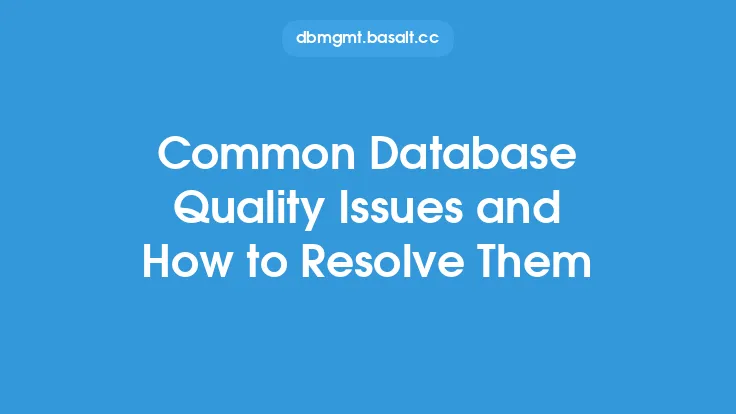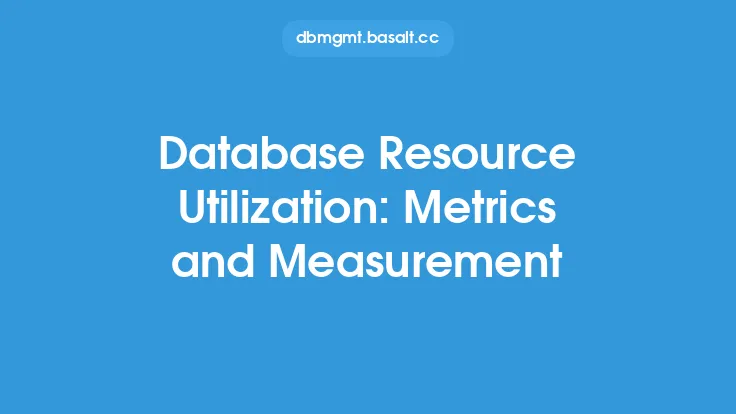Measuring and improving data quality is a crucial aspect of database administration, as it directly impacts the reliability and accuracy of the data stored in the database. Database quality metrics provide a way to assess the quality of the data and identify areas that require improvement. In this article, we will delve into the different types of database quality metrics, how to measure them, and strategies for improving data quality.
Introduction to Database Quality Metrics
Database quality metrics are quantitative measures used to evaluate the quality of the data in a database. These metrics can be categorized into several types, including accuracy, completeness, consistency, timeliness, and validity. Accuracy metrics measure the degree to which the data is correct and free from errors. Completeness metrics assess the extent to which the data is comprehensive and includes all required information. Consistency metrics evaluate the uniformity of the data and ensure that it adheres to a set of predefined rules. Timeliness metrics measure the time it takes for data to be updated or refreshed, while validity metrics verify that the data conforms to a set of predefined rules or constraints.
Types of Database Quality Metrics
There are several types of database quality metrics, each measuring a specific aspect of data quality. Some of the most common metrics include:
- Data accuracy metrics: These metrics measure the degree to which the data is correct and free from errors. Examples include error rates, data entry accuracy, and data validation metrics.
- Data completeness metrics: These metrics assess the extent to which the data is comprehensive and includes all required information. Examples include data coverage, data density, and data missingness metrics.
- Data consistency metrics: These metrics evaluate the uniformity of the data and ensure that it adheres to a set of predefined rules. Examples include data format consistency, data value consistency, and data relationship consistency metrics.
- Data timeliness metrics: These metrics measure the time it takes for data to be updated or refreshed. Examples include data update frequency, data latency, and data freshness metrics.
- Data validity metrics: These metrics verify that the data conforms to a set of predefined rules or constraints. Examples include data type validity, data range validity, and data format validity metrics.
Measuring Database Quality Metrics
Measuring database quality metrics involves collecting and analyzing data from various sources, including database logs, data entry forms, and data validation rules. The following steps can be taken to measure database quality metrics:
- Identify the metrics to be measured: Determine which metrics are relevant to the database and the organization's goals.
- Collect data: Gather data from various sources, including database logs, data entry forms, and data validation rules.
- Analyze data: Use statistical methods and data analysis techniques to analyze the collected data and calculate the metrics.
- Interpret results: Interpret the results of the analysis and identify areas that require improvement.
Improving Database Quality
Improving database quality involves implementing strategies to address the issues identified through the measurement of database quality metrics. Some strategies for improving database quality include:
- Data validation: Implementing data validation rules to ensure that data is accurate and consistent.
- Data normalization: Normalizing data to ensure that it is consistent and follows a set of predefined rules.
- Data standardization: Standardizing data to ensure that it is consistent and follows a set of predefined rules.
- Data cleansing: Cleansing data to remove errors and inconsistencies.
- Data transformation: Transforming data to ensure that it is in a format that is consistent with the database's requirements.
- Data quality monitoring: Continuously monitoring data quality to identify and address issues as they arise.
Best Practices for Implementing Database Quality Metrics
Implementing database quality metrics requires careful planning and execution. The following best practices can be followed to ensure successful implementation:
- Establish clear goals and objectives: Clearly define the goals and objectives of the database quality metrics program.
- Identify relevant metrics: Identify the metrics that are relevant to the database and the organization's goals.
- Develop a data quality plan: Develop a plan that outlines the steps to be taken to measure and improve data quality.
- Implement data validation rules: Implement data validation rules to ensure that data is accurate and consistent.
- Continuously monitor data quality: Continuously monitor data quality to identify and address issues as they arise.
- Provide training and support: Provide training and support to users to ensure that they understand the importance of data quality and how to maintain it.
Common Challenges in Implementing Database Quality Metrics
Implementing database quality metrics can be challenging, and several common challenges may arise. Some of these challenges include:
- Lack of resources: Implementing database quality metrics may require significant resources, including time, money, and personnel.
- Lack of expertise: Implementing database quality metrics may require specialized expertise, including knowledge of data analysis and statistical methods.
- Data complexity: Database quality metrics may be difficult to implement in complex databases with large amounts of data.
- Resistance to change: Users may resist changes to the database or data entry processes, making it difficult to implement database quality metrics.
- Balancing data quality with other priorities: Implementing database quality metrics may require balancing data quality with other priorities, such as data security and performance.
Conclusion
Database quality metrics are essential for ensuring the accuracy, completeness, and consistency of data in a database. By measuring and improving data quality, organizations can improve decision-making, reduce errors, and increase efficiency. Implementing database quality metrics requires careful planning and execution, and several best practices can be followed to ensure successful implementation. Common challenges may arise, but with the right resources and expertise, organizations can overcome these challenges and achieve high-quality data.





